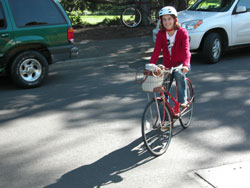Berkeleyan
Making the most of their commute
For many Berkeley faculty, time spent cycling is time well spent
![]()
| 17 March 2004
| |  Sofia Berto Villas-Boas commutes to her office in Giannini Hall on her $10 “garage sale special.” Other faculty cyclists ride spiffier wheels, but all enjoy the same freedom of the road and (if they choose their route carefully) safety from Berkeley’s notorious drivers. |
With its relatively flat terrain and dedicated bike lanes, Berkeley is a good place to cycle — which is why the Berkeleyan had little trouble identifying many faculty who commute to work on two wheels. But what about the town’s notorious traffic? Thomas Bruns, an associate professor of plant and microbial biology who has been biking three miles each way from the bottom of Albany Hill since 1987, reports “it’s easy to choose a route where traffic is not an issue.”
David Levine, a professor at the Haas School of Business, also rides three miles to work — but not in a row. Levine has a BART trip sandwiched in between the two bicycle legs of his trip. His days begin with a one-mile ride from his home in Lafayette to the BART station there, where he leaves his bike in a locker. He exits at the Rockridge station, then retrieves a second bike from a locker there for the two-mile ride to Haas.
When William Oldham, professor emeritus of electrical engineering and computer sciences, elects to cycle to work, he does so for the exercise. “It’s only about eight miles and 800 feet of climbing from my house in Orinda to Cory Hall,” says Oldham. “That’s the easy way; it takes about 35 minutes.”
For a more strenuous workout, Oldham tacks on extra miles and elevation. “If I add Happy Valley or Wildcat Canyon to my route, my ride is extended to about 12 miles and 1,500 feet, taking about 70 or 80 minutes,” he explains, not at all breathlessly.
Sofia Berto Villas-Boas, assistant professor of agriculture and resource economics, appreciates that when she rides to Berkeley on her $10 garage-sale special, she will arrive at her Giannini Hall office in a speedy seven minutes. Her door-to-door time includes hitting the brakes at stop signs, a practice she says seems to surprise automobile drivers.
Oh, the people you’ll meet!
Anthropology professor Nancy Scheper-Hughes has been commuting on two wheels for more than 25 years, since her first teaching job at Southern Methodist University. She also bicycled her way through the Peace Corps in Brazil and a year and a half of civil-rights work in Selma, Alabama.
“The benefit of bike riding is that you meet people you normally wouldn’t encounter if you were driving,” she says. “In most parts of the third world, an outsider who rides in on a bike is automatically not considered [part of] the elite.”
In 1994-95, Scheper-Hughes was appointed chair of anthropology at the University of Capetown, South Africa, where she caused some consternation among the “very progressive, liberal-leaning white administrators” by insisting on entering townships on a bike. Though the administration thought it was beneath her status, Scheper-Hughes biked boldly onward.
Riding high and falling hard
Catherine Wolfram, an assistant professor at the Haas School who has been riding her hybrid bike a mile to campus for more than three years, likes “the easy parking and the fact that it’s cheap.”
Others embrace such practicality, but stop to smell the roses too. “I enjoy the whole process,” says Thomas Bruns. “It gives me a little exercise, and I often think about things on my way in. At this time of year it’s particularly pleasurable, with all the aromas of spring.”
Many faculty we spoke with recommended that the university improve parking and security for bicyclists, adding those factors to a list of concerns headed by the threat to life and limb posed by traffic. On the plus side, most appreciated the fact that they don’t need to “waste time in a car,” as Joel Fajans of physics puts it, to get to work.
On top of the other perks, one less-obvious advantage was mentioned. “We’ve been waiting for good weather,” says David Levine, referring to his many Haas colleagues who cycle to work, “so we can bike over to the Cheeseboard for lunch.”
Berkeley’s Department of Parking & Transportation will begin work on a campus bicycle plan later this year, to be completed in February 2006. The plan will consider such issues such as bicycle access to the campus from adjacent streets and public transit; bicycle, vehicle, and pedestrian interaction; bicycle parking, safety, incentive programs, education, and enforcement; and amenities such as showers. For information, contact Kira Stoll at stoll@uclink.berkeley.edu or 643-9276.

